| Back to Back Issues Page |
 |
|
Bangkok Travelbug February 2016 Thai Tourism Fair 2016 January 28, 2016 |
| Hello
Northeast Region or Isarn Visitors who enter Lumphini Park from the Sala Daeng entrance will proceed to the displays from the North-eastern region. They will encounter the sight of these long garlands strung up on poles. These garlands aren’t made from flowers, they are "malai khao dork" or popped rice garlands. 
Malai khao dork – popped rice garlands from Yasothon Unhusked rice is heated to produce popped rice which is similar to popcorn. The popped rice grains are strung into beautiful garlands of various designs. This custom is observed on Makha Bucha Day (Buddhist All Saints’ Day) by the people of Ban Fa Yat, Maha Chana Chai district in Yasothon province. In the evening, the garlands made by the community are paraded and brought to Wat Ho Kong to be offered to Buddha. 
The display station from Yasothon Makha Bucha Day falls on the 15th night of the waxing moon in the 3rd lunar month. This year it falls on 22 February 2016. It commemorates the day when 1,250 disciples of Buddha who were ordained by him and all of whom have attained Enlightenment, gathered impromptu at a park to listen to a sermon by Buddha. Next display is from Udon Thani the location of the Ban Chiang archaeological site with relics from a civilization more than 5,000 years old. The pottery here is painted with the designs of the pre-historic pottery found at this archaeological site which was designated a UNESCO World Heritage site in 1992. 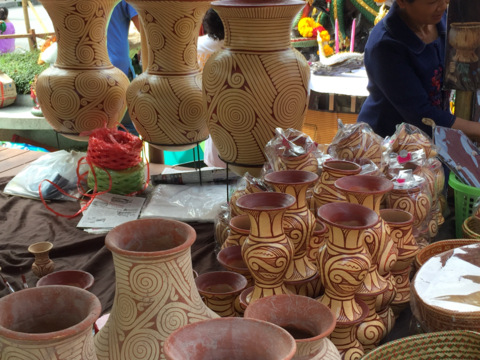
Pottery pained with the Ban Chiang designs Nakhon Phanom on the banks of the Mekong presents its bamboo mouth organs, lutes and flutes. 
Bamboo musical instruments from Ban Na Wa, Tha Rua district, Nakhon Phanom The Phu Tai of Ban Kutwa, Kuchi Narai district, Kalasin have an exquisite handicraft of bamboo garlands to celebrate their Boon Khan Pradub Din Festival on the 9th and 10th lunar months. 
Bamboo garlands from Kalasin The Phu Tai were originally from Dien Bien Phu in north western Vietnam, they later migrated to Laos and then to Thailand in the 1800s. There are several Phu Tai communities in north-eastern Thailand 
Decorative items made from bamboo at the Kalasin station For more on the Phu Tai of Kalasin 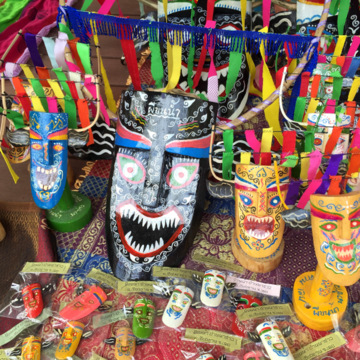
Masks for the ghost festival in Amphur Dan Chai, Loei 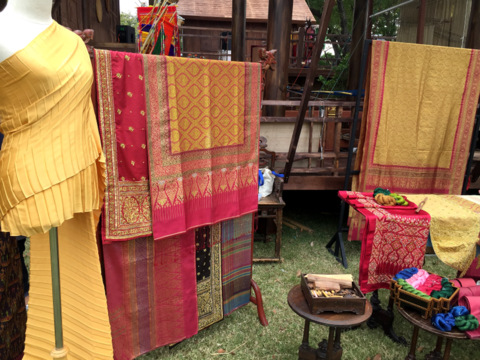
Golden mantle silk from Ban Tha Sawang, Surin 
The unmistakable designs of Phrae Wa silk from Ban Phon, Kalasin 
Cultural dancers from the northeast preparing for their performance Contents Southern Region There’s a noticeable a change of setting, dress, handicraft and products as we move to the displays from the Southern Region. The provinces on Thailand’s southern borders and some of the Malay states in northern peninsular Malaysia were once part of the Pattani kingdom and we shall see some common cultural traits. 
Kris dagger maker from Yala, a province in southern Thailand with common borders with Kedah and Pahang in Malaysia 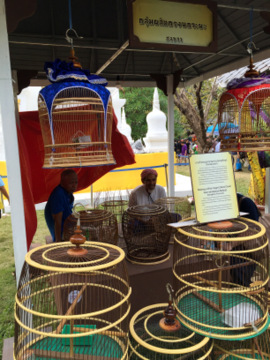
Bird cage makers from Songkhla 
Wickerwork from Phatthalung made from a grass called krachut or Cyperaceae (sedges) 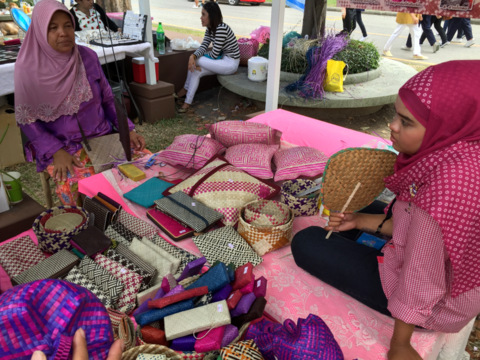
Wickerwork from Krabi made from the screw or Pandanus pine Nang talung shadow drama is a speciality of Nakhon Sri Thammarat and consists of puppets carved into different shapes from cowhide and painted. These puppets are moved behind a screen with a light shining on them thus casting their shadows on the screen. The drama is performed with traditional musical instruments and a narrator. Its Malay equivalent is wayang kulit performed in the northern Malaysian states. 
Nang talung There was a long queue for this drink, cha chak or teh tarik in Malay, dragging the tea to produce a frothy brew. This stall is from Satun, a province across the border from the Malaysian state of Perlis. 
Cha chak from Satun However one exhibit in the Southern Region display area that stood out was the reconstruction of a Chinese shrine from Pattani. This is the Chaomae (Goddess) Lim Ko Niao Shrine that was built during the Ming Dynasty in 1574! 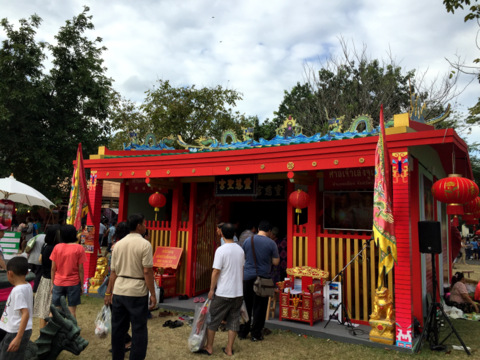
Lim Ko Niao Goddess Shrine, Pattani Contents Northern Region A beautiful arch of flowers welcomes visitors to the Northern Region display area. There are two major attractions here; a wide selection of silks from the various provinces in the north and scaled-down models of local markets from the north with their specialities. 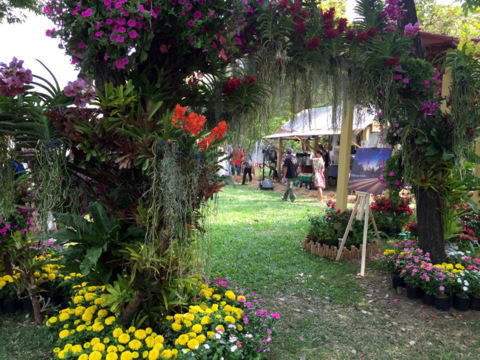
The floral arched entrance to the northern region 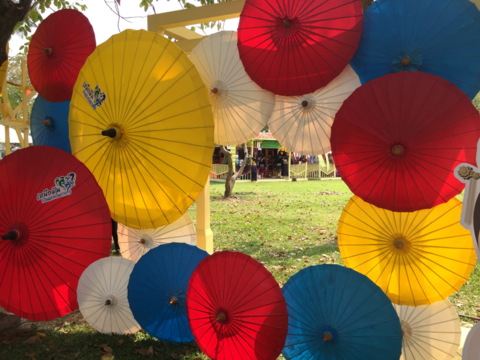
Colourful umbrellas from Bo Sang, Chiang Mai 
Silks from Uthai Thani 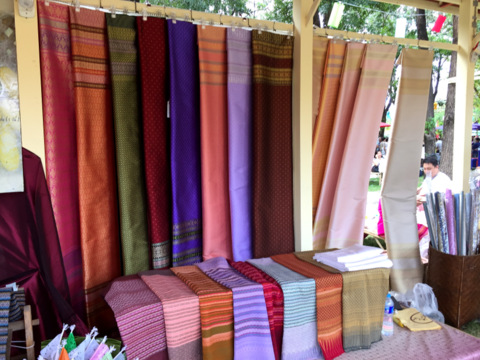
Silks from Lamphun 
Akha fabrics from Ban Lorcha, Chiang Rai 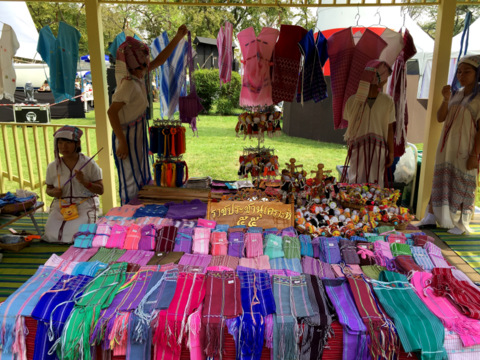
Woven bags by the Karens from Tak The model markets from the north are based on markets in Lampang, Lamphun, Petchabun, Sukhothai and Tak. 
Northern deserts with different flavours 
Drink from Sukhothai blended from young rice shoots 
Pad Thai from Sukhothai Contents Eastern Region Visitors on entering the display of the Eastern Region will meet this figure of Phra Aphai Mani, a character from the most famous work of Thailand’s Poet Laureate, Sunthorn Phu, a native of Klaeng, Rayong. For more on Rayong the poet’s inspiration 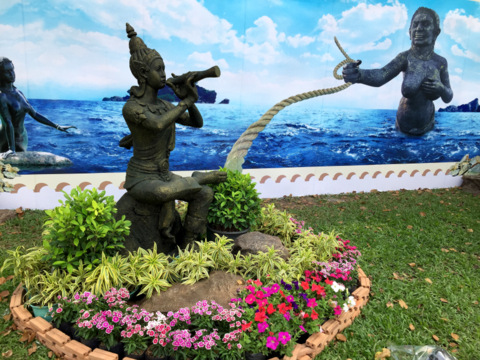
Phra Aphai Mani playing his magic flute that could even charm the ocean ogress The Eastern Region covers the coastal provinces of Chonburi, Rayong, Chanthaburi and Trat popular for their beaches and island resorts and the inland provinces of Prachinburi and Sa Kaeo. 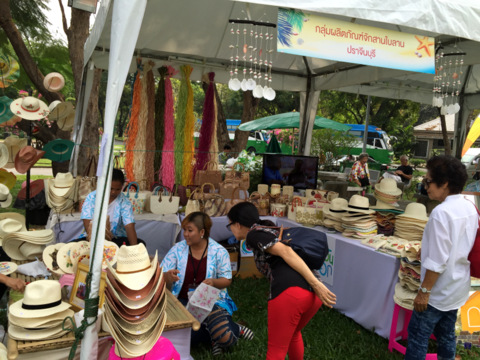
Hats from Prachinburi made from bai lan, the leaves of the fan palm Here’s something very special from Sa Kaeo on the Thai-Cambodian border. The handicraft involves weaving bamboo jackets with intricate designs to fit ceramic vases of various shapes. This is done by a group of housewives from Sa Kaeo. 
Bamboo wickerwork wrapped on ceramics 
Mortars and pestles from Angsila, Chonburi 
Hand-woven fabrics from Ban Puek, Chonburi Khao Lam consists of sweetened glutinous rice grilled in bamboo tubes over a coal fire, a speciality of Chonburi and the eastern coastal provinces. 
Khao Lam from Chonburi Contents Central Region The Central Region consists of the provinces in the Chao Phraya basin and the main agricultural activity is rice planting. The stage here is actually a traditional Thai house from the Central Region, an indication of the painstaking care taken to create a realistic atmosphere for the fair. 
Stage in the Central region 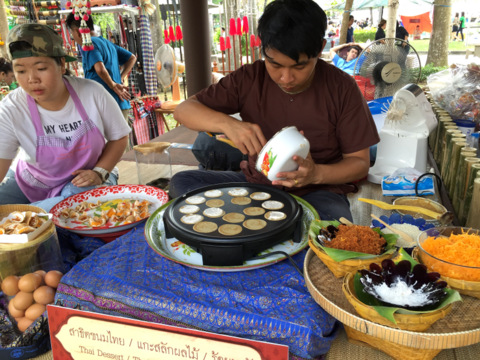
Kanom bueng is a popular Thai desert made from flour, eggs and coconut shavings 
Masks for the Khon drama This display from Ayutthaya consists of intricate designs of fish (pla taphian) woven from the leaves of the fan palm (bai larn). 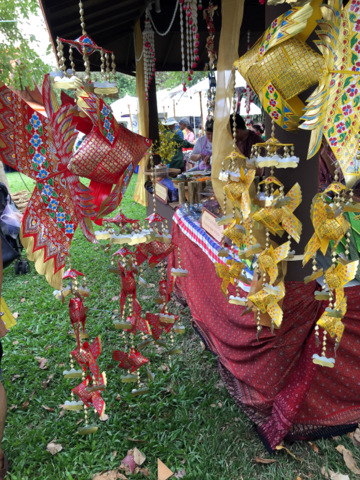
Pla taphian Lastly we have the distinctive Benjarong ceramics from Ban Don Kai Dee, Samut Sakhon. 
Benjarong ceramics Contents Floating markets The lake in the centre of Lumphini Park was converted to a huge floating market scene for stalls by the waterside and boat vendors. Here’s where I took a break and had my desert of coconut juice and coconut ice cream. 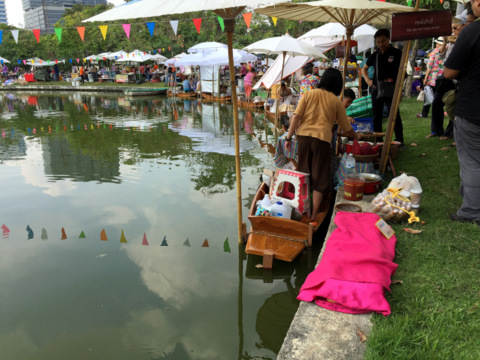
Floating market in the lake Thank you for joining us on this quick tour of a cross-section of Thailand to have a brief idea of her people, culture, handicraft and food. I’ve tried to include as much as time and space permit. Hope you enjoyed it and see you again next month. Contents Map to Lumphini Park If the map doesn’t appear, click on this link How to get there By skytrain or subway Take the skytrain (BTS) to the S2 Sala Daeng station or the subway (MRT) to the (SIL) Silom station and walk to the main entrance of the park where the King Rama VI Monument is located. From the Silom subway station visitors can walk right out to the main entrance of the park which is opposite the Dusit Thani Hotel. Admission is free Opening times The Thai Tourism Fair 2016 was held from 13 – 17 January from 1200 – 2200 hours. This fair is usually held at Lumphini Park, Bangkok annually around mid-January. Don’t miss it next year. It’s suggested you visit the fair on a weekday in the early afternoon. It’s less crowded; you can have a closer look at the displays, better photo opportunities and a more leisurely visit. Contents Next month Suphanburi National Museum, Suphanburi If you enjoyed reading this e-zine, please forward it to a friend. If you received this from a friend and found it interesting, please subscribe at Bangkok Travelbug. What do you think of the Bangkok Travelbug? We love to hear from you What other subscribers have said Till next month then. Eric Lim Tour Bangkok Legacies Find us on Facebook If you are an independent traveller, here's a handy e-guide book, Tour Bangkok Legacies, which will help you along as you explore the streets of Bangkok and discover its old treasures. It's complete with historical descriptions, maps and detailed directions on how to get to these places. My Kindle e-book 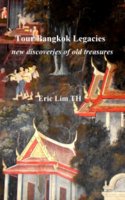
Copyright@2008-2016 Tour Bangkok Legacies All rights reserved |
| Back to Back Issues Page |